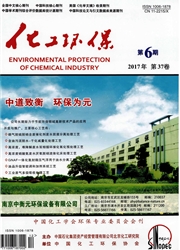

 中文摘要:
中文摘要:
结合NDA-150型树脂(简称树脂)选择性吸附和生物降解的优点,对含硝基苯和苯酚的模拟混合废水(简称混合废水)进行处理。通过树脂的选择性吸附,使混合废水中的硝基苯和苯酚分离,随后用高效菌对树脂所吸附的硝基苯进行生物降解,同时实现树脂的再生。实验结果表明:通过调节混合废水的pH,树脂可有效地将混合废水中的硝基苯和苯酚进行选择性吸附分离;树脂对硝基苯的吸附是可逆的;树脂的再生程度受微生物对可利用硝基苯质量浓度的下限(1.2mg/L)限制;吸附-生物再生循环实验结果表明,该树脂可有效抵抗微生物的生物降解与破坏。
 英文摘要:
英文摘要:
The mixed wastewater containing nitrobenzene and phenol was treated by the process combining the merit of selective adsorption on resin NDA 150 with that of biodegradation. Nitrobenzene and phenol in the mixed wastewater were separated by selective adsorption on resin, and then the nitrobenzene adsorbed on the resin was biodegraded by high efficiency degrading bacteria. At the same time, the resin was regenerated. The experimental results indicate that after pretreatment by selective adsorption on resin, the toxic inhibition of nitrobenzene on phenol degrading bacteria was relieved, and phenol in the adsorption effluent can be degraded stably and effectively by phenol degrading bacteria. As a result, different pollutants in the mixed wastewater can be biodegraded efficiently.
 同期刊论文项目
同期刊论文项目
 同项目期刊论文
同项目期刊论文
 Adsorption characteristics of fumaric acid onto weakly basic hypercrosslinked polystyrene ion-exchan
Adsorption characteristics of fumaric acid onto weakly basic hypercrosslinked polystyrene ion-exchan Study on the formation mechanism of oxygen-containing groups on the surfaces of hypercrosslinked pol
Study on the formation mechanism of oxygen-containing groups on the surfaces of hypercrosslinked pol Adsorption of dyes and phenol from water on resin adsorbents: Effect of adsorbate size and pore size
Adsorption of dyes and phenol from water on resin adsorbents: Effect of adsorbate size and pore size Preparation and characterization of polymer-based spherical activated carbons with tailored pore str
Preparation and characterization of polymer-based spherical activated carbons with tailored pore str Polanyi-based models for the adsorption of naphthalene from aqueous solutions onto nonpolar polymeri
Polanyi-based models for the adsorption of naphthalene from aqueous solutions onto nonpolar polymeri Biotreatment of p-nitrophenol and nitrobenzene in mixed wastewater through selective bioaugmentation
Biotreatment of p-nitrophenol and nitrobenzene in mixed wastewater through selective bioaugmentation Preparation and characterization of highly mesoporous spherical activated carbons from divinylbenzen
Preparation and characterization of highly mesoporous spherical activated carbons from divinylbenzen 期刊信息
期刊信息
